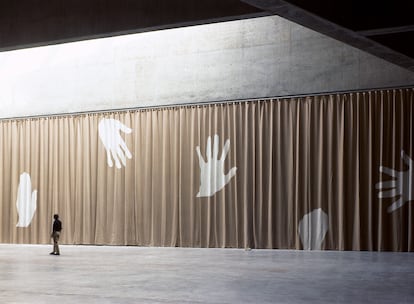The curtains, the large curtains, are a paradoxical element. They hide and underline at the same time. They provide privacy and create mystery. In contrast to the phallic sexuality that is attributed to skyscrapers, the curtains invite a sensuality voyeur.
The fabrics, from which they are made, domesticate spaces, but they can also magnify them, wrap them and disguise them, especially when the scale of this element skyrockets, it is complemented with complex sections and color takes center stage. This is what happened, and happens, with some of the buildings of the Dutch studio OMA.
Just outside Paris, the Vila dall’Ava in Saint-Cloud opened to views of the Eiffel Tower and closed with a large golden curtain. Something similar happened later with the house, Villa Floriac, that Rem Koolhaas and his team, OMA, signed for the Lemoines in Bordeaux. The house became famous for its free section: all the floors were interrupted, with holes, when the owner of the house – a journalist who had to move around in a wheelchair after an accident – was not present on that floor. The absence of those who could not move was present. But it was the large dark and velvety curtains that embraced and rethought both the interior and the platform that pierced and completed the floor.
Koolhaas himself said it: “It is impossible to separate my work from that of Petra Blaisse.” He told it in a conference that can now be read in the book Art Applied (Mack Books) edited by Fredi Fishli and Niels Olsen. He himself added that all that, the curtains, the vegetation, the carpets, was architecture. It had nothing to do with the fact that, as the years went by, the two of them became a couple.
Koolhaas met Blaise when, after studying Fine Arts, she worked as an assistant at the Stedelijk Museum in Amsterdam. She had another way of narrating and telling the exhibitions. Fascinated, Koolhaas commissioned the exhibition at the Bojimans van Beuningen in Rotterdam to show 10 years of production in his OMA studio. What Petra Blaisse (1955) did in 1986 was to take a risk: instead of explanatory texts she posted collagesa mix between a teenager’s room and the anticipation of a Facebook wall. Those plastics were his first curtains. Those of the Dance Theater in The Hague, which OMA completed the following year, would be their first collaboration.
the book Art Applied accounts for those works. Of the rotundity of a curtain, of its flexibility, of the changing and fluid limit that it builds. “What we try to do from our studio is see everyday life in a different way.”
The studio he’s talking about is called Inside Outside and it’s in Amsterdam. Blaisse founded it in 1991. And today she works with multiple artists and landscapers and is associated with Jana Crepon and Aura Luz Melis. They all talk about things like an “archive of knowledge” – a kind of collection of finds (seeds, shells, stones from which they draw inspiration), care, community – they cook and eat together daily – and “recipes for invention”. That’s what the book offers. Art Applied (it could not be translated as applied arts but rather as “applying art”), it seems like a small change, but it is substantial.
An essential curtain
Can a curtain be an essential part of a building? OMA and Blaise have shown that it can transform you.
First you can ask questions, which is how they started working: Why can’t an audience be purple or pink instead of gray or black?
Secondly, a curtain is a mobile, versatile element that can change the order of a property.
The curtain, the drapery – those in Inside Outside are spectacular and fall many meters – introduces movement, immediate and easy capacity for transformation, sound and even smell in the architecture. It allows you to rethink the interiors. It is a complete architectural element. So much so, that it has a story.
The curtains covered the modern and exquisite coldness of Mies van der Rohe when, with the help of Lilly Reich, he designed the Silk Café in Berlin. There are many architects who have used textiles in their work. Lina Bo Bardi also used them as an architectural device in her home in São Paulo. But so did Adolf Hitler’s advisors, each time unfurling the red tapestry with a swastika in the center.

It happened in the Haus de Kunst in Munich. That’s why when Blaise and his team intervened, they used fabrics to break the symmetry, add a layer to the past, transform it into another present.
This flexibility and transformative mobility has its continuity, not its opposite, in the work with nature, the other side of the Inside Outside study. Let’s see why.
The curtain, the large curtains, are inaugurated at their best and then, like any architectural element, they reveal the trace of time – the deposit, the wear and tear – on them.
With nature – in the plant tapestries with which this study completes roofs, walls and exteriors – the opposite happens. The passage of time alters it and, if it is cared for, improves it and brings it to splendor. Outside you can also take risks. “You can paint with plants,” explains Blaisse. The point is not to be afraid of being strange. Gertrude Jekyll did it: she mixed plants to bring the picturesque garden to life. Chance led her to that combination: she was colorblind and did not distinguish red from green. But his work spread to more than 400 British orchards.
Blaisse has worked, inside and outside, around the world. The interior is transformed with fabrics that cover the daring and purposeful architecture of OMA. The exterior, with shrubs that live without hardly any water such as the ziziphus and the thorn-umbrella trees that he planted next to the Doha Library, designed by OMA.

